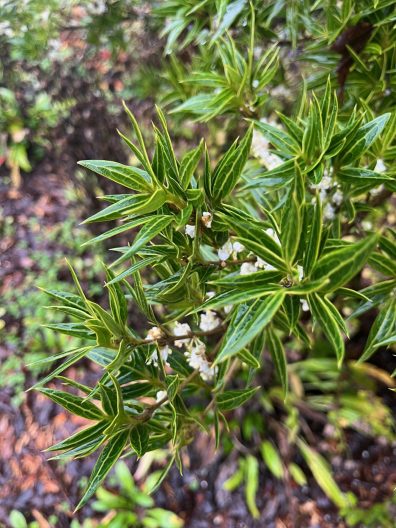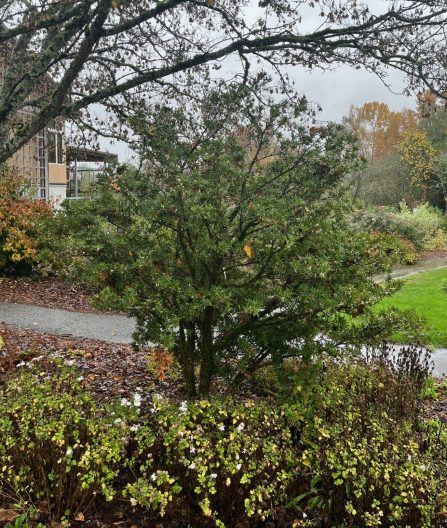November Plant Profile: Osmanthus heterophyllus ‘Sasaba’
 Common name: Bamboo leaf osmanthus, Bamboo leaf tea olive
Common name: Bamboo leaf osmanthus, Bamboo leaf tea olive
Family: Oleaceae (olive family)
Location: In the Arboretum, several at southeast corner of intersection of Arboretum Drive E and E Foster Island Road in Grid 43-4E, at CUH in beds west of Merrill Hall by parking lot and Miller Library (CUH-MH-W)
Origin: Osmanthus heterophyllus ‘Sasaba’ is a selection of the holly-leaf osmanthus (Osmanthus heterophyllus) from Japan. It was introduced to America in the late 1970s but until recently was scarce in commerce. ‘Sasaba’ means “bamboo leaf” in Japanese, giving rise to the common English name.
Attributes: Osmanthus heterophyllus ‘Sasaba’ is one of my favorite plants in this highly useful genus. It combines the durability of the holly-leaf osmanthus with unusual and attractive evergreen leaves and fragrant fall bloom on a smaller scale plant. ‘Sasaba’ grows slowly to 5-7 feet tall in time and about 2/3 as wide, but is easy to keep in containers for many years and amenable to pruning. This, like most osmanthus available in the Pacific Northwest, is very tolerant of both sun and shade in our climate and not fussy about soils, provided they are not poorly drained. It is very trouble free with no disease or insect issues, and very drought tolerant once established. ‘Sasaba’ is always a great conversation starter due to its unique leaves, which are dark green with many spine-tipped lobes. It is quite unlike any other osmanthus or any common landscape shrub. And as an added bonus, ‘Sasaba’ produces small, fragrant white flowers in fall, usually peaking in early November. The sweet scent can carry several feet and this is one of the few flowering plants in the landscape this time of year.
I first encountered this at the former Heronswood Nursery in the 1990s, when it was still very hard to find. While I don’t generally favor prickly leaves, this isn’t nearly as pokey as most hollies, being less thick and rigid and more forgiving to touch. However, it is very useful as an informal hedge and a good visual and physical deterrent to shortcuts through garden beds. It looks wicked but not enough to fear gardening around.
Our largest plant is at CUH, and was donated in 2015 by Martha Ferguson, longtime librarian at the Miller Library. She had used it for many years as a plant in her parking strip, where its slow growth, drought tolerance and durability were perfect for conditions where many species fail to thrive.
strip, where its slow growth, drought tolerance and durability were perfect for conditions where many species fail to thrive.
Osmanthus heterophyllus ‘Sasaba’ is becoming easier to find. Larger local nurseries will sometimes offer plants in 1 to 2 gallon sizes. It is worth searching for and may also be found through mail order nurseries.
Height and spread: While Osmanthus heterophyllus can eventually reach 20’ tall, ‘Sasaba’ is unlikely to ever grow much past 10 over many decades. It grows about 1/3 taller than wide. It is easy to keep smaller with occasional pruning, and plants will be denser and more compact in sunnier sites than shade. This will also help with flower production. Unlike many other selections of the holly leaf osmanthus, this will sometimes produce fruit and last year saw our largest plant with a modest crop of small, oval, blue-black berries.
Hardiness: Cold hardy to USDA Zone 6a (-5 to -10 degrees F)